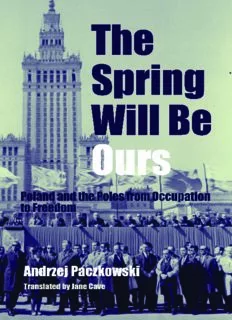
The Spring Will Be Ours: Poland and the Poles from Occupation to Freedom PDF
Preview The Spring Will Be Ours: Poland and the Poles from Occupation to Freedom
the spring will be ours ..........................10230$ $$FM 09-16-0315:49:12 PS The Spring Will Image not available ..........................10230$ $$FM 09-16-0315:49:14 PS Be Ours Poland and the Poles from Occupation to Freedom Image not available Andrzej Paczkowski Translated byJane Cave the pennsylvania state university press university park, pennsylvania ..........................10230$ $$FM 09-16-0315:49:15 PS Disclaimer: Some images in the original version of this book are not available for inclusion in the eBook. FirstpublishedinPolandasPo´łwiekudziejo´w LibraryofCongressCataloging-in-Publication Polski,1939–1989. Data Copyright(cid:1)1995byWydawnictwoNaukowe PWNSp.zo.o.,Warszawa. Englishtranslationcopyright(cid:1)2003 Copyright(cid:1)1998byWydawnictwoNaukowe the pennsylvania state university PWNS.A.,Warszawa. Allrightsreserved PublishedbyarrangementwithPolishScientific PublishersPWN. PrintedintheUnitedStatesofAmerica Publishedby Publicationofthistranslationhasbeenfunded ThePennsylvaniaStateUniversityPress, bytheAdamMickiewiczInstitute—thePolish UniversityPark,PA16802-1003 LiteraryFund ThePennsylvaniaStateUniversityPressisa memberoftheAssociationofAmerican UniversityPresses. ItisthepolicyofThePennsylvaniaState UniversityPresstouseacid-freepaper. Publicationsonuncoatedstocksatisfythe minimumrequirementsofAmericanNational StandardforInformationSciences—Permanence ofPaperforPrintedLibraryMaterials, ansiz39.48-1992. ..........................10230$ $$FM 09-16-0315:49:15 PS Contents PrefacetotheAmericanEdition vii GlossaryofAbbreviations xiii introduction TwentyYearsofIndependence 1 chapter 1 CaptivityandStruggle 37 chapter 2 TwoPolands 121 chapter 3 TheNewReality 146 chapter 4 ConstructingtheFoundations 198 chapter 5 RealSocialism:TheIronFist 279 chapter 6 RealSocialism:LaBelleEpoque 351 chapter 7 TheLongMarch—Prologue 411 chapter 8 TheLongMarch—WarandPeace 446 postscript PolandAfterCommunism 507 Appendix:TableofSeniorStateOfficials 537 BiographicalNotes 541 BibliographybyPadraicKenney 553 Index 563 ..........................10230$ CNTS 09-16-0315:49:19 PS ..........................10230$ CNTS 09-16-0315:49:19 PS Preface to the American Edition without much difficulty onecanfindcountriesandnationsthatman- aged to stay out of trouble while traversing the twentieth century. Revolu- tionsandsocialupheavalspassedthemby,nointernationalarmedconflict took place on their territory, civil rights were respected, living conditions improved, andnew technologiesrapidly made their way intothe everyday lives of at least the majority of their citizens. Some of these countries, like New Zealand, were situated far from the epicenter of disturbances and wars; others, like Switzerland, managed to protect themselves from the storms of history even though terrible human tragedies were occurring close by. Such countries and nations are, however, far outnumbered by thosethatstruggled,oftenconstantly,withsevereinternalconflicts,fought in bloody wars, or were attacked by their neighbors and deprived of their sovereignty. One of the countries subjected to such painful trials and tribulations was Poland. This in itself is no reason to pay it particular attention, since any attempt to establish a ranking in terms of casualties, to calculate who enduredthegreatestwrongsorsufferedthegreatestlosses,iswithoutintel- lectual significance, although it has considerable importance in national mythology and relations between nations. It seems to me that an outside observerwillfindthehistoryofPolandandthePolesofinterest,notbecause of the casualties, although there were many, but because on several occa- sionsinthetwentiethcenturythisrelativelysmallcountryinfluenceddevel- opmentsonabroader,globalscale.Thiswasthecasein1920,whenPoland, newly reborn after more than a century of continuous occupation, fought off an offensive mounted by the Red Army, thus preventing the Bolshevik revolutionfromspreadingtoWesternEurope.Therevolution’sdestructive potential was thereby reduced, although not destroyed, as the Soviet Union’sneighborsweremadealltoopainfullyawarein1939–40.Thiswas the case in 1939, when Poland became the first country to reject Hitler’s dictatorshipandtakeupthechallengetowagewaragainstNaziGermany, at that time the most bloodthirsty country in Europe, thus providing an vii ..........................10230$ PREF 09-16-0315:49:24 PS preface to the american edition example of how, if all other means fail, a country must take up arms to defenditsindependence.Thiswasalsothecasein1989,wheninternalso- cial conflict in Poland set in motion a process that began to transform the system.This hada dominoeffect acrossthewhole Sovietbloc; attemptsto reform real socialism were abandoned, the entire system was discarded, andtheSovietUnionitselfcollapsed. Ofcourse,IamnottryingtoarguethatPolandwasthesolecausalfac- tor,but onlythatits rolewassignificantbecauseitobligedothercountries to take action that had far-reaching consequences. In the first case, it caused the Bolshevikrevolution to remain confinedwithin the boundaries ofasmallerRussianempire,afactorthatundoubtedlyinfluencedtheshape of the Soviet system. In the second case, it prompted the formation of the anti-Nazi coalition that finally defeated Hitler. In the third case, it showed thatitwaspossibletodismantlethecommunistsystempeacefullyandthus encourageditscommunistneighborstomakesimilarefforts.Thehistoryof Polandisthereforeinterestingnotjustinitselfbutalsobecausetheevents thattookplaceinthecountryhadanimpactonothercountries,eventhose thatweremuchmorepowerful. In his book, The Age of Extremes, the noted British Marxist historian EricHobsbawmintroducedthenotionof“theshorttwentiethcentury.”This covers the years 1914–91, in other words the period from the eruption of World War I to the collapse of the Soviet Union. This approach works well intermsofworldhistory,althoughindividualcountriesmayhavedifferent chronologicalboundaries.InthecaseofPoland,Hobsbawm’sboundariesfit fairly well: the outbreak of World War I and its subsequent course were indeeddecisiveintherebirthofthePolishstate,andthefallofthecommu- nistsysteminPolandprecededthecollapseoftheSovietUnionbyonlytwo years.OnecouldevenarguethatPolanddidnotfinallybidfarewelltocom- munismuntilthedisappearanceoftheSovietUnion,whichafter1989was the only force capable of reinstalling the system in Poland, just as it had engineered its creation in 1944–45. My ambitions are, however, far more modest than those of the author of The Age of Extremes. Not only because this book deals with the history of Poland, and world history appears only inthedistantbackground,butalsointhesensethatitfocusesonthesecond halfoftheshorttwentiethcentury,fromtheoutbreakofWorldWarIItothe fallofcommunism. Iaminterestedintwomainquestions:Howwasasys- temasuniversalascommunismintroducedandmadetofunctioninacoun- try that Lenin saw as the implacable foe of the Bolshevik revolution? And: viii ..........................10230$ PREF 09-16-0315:49:24 PS preface to the american edition Howdidanationthathadforyearsequatedanticommunismandanti-Sovi- etismwiththeinterestsofbothitselfandthestateadapttothissystem? The main part of the book begins with the outbreak of World War II, sinceit wasat thatpoint—or moreprecisely, on23 August 1939, when the SovietUnionandtheThirdReichsignedwhatbecameknownastheRibbe- ntrop-Molotovpact—thattherebeganasequenceofeventsthatledtofun- damentalchanges inthe affairsof Poland.As aresult ofMoscow’s shifting alliances(initiallywithGermany,andthen,frommid-1940,withBritainand theUnitedStates)andthemilitarycampaignthatendedwiththetriumphal entry of the Red Army into Berlin, Poland was changed completely. It was not just that the borders had moved or that the Holocaust and the subse- quent resettlement of millions had altered the national composition of the population; Poland became part of the Soviet “internal empire” and was forcedtoadopttheSovietpoliticalsystem.Itwouldthereforebedifficultto understandwhathappenedaftertheendofthewarwithouttakingalookat whathappenedduringthewar,withtheprovisothatIbelievetheattitudes ofthepopulationandthebehaviorofthePolishpoliticalelite,aswellasthe position of the Soviet Union and the Third Reich in relation to Poland and itsinhabitants,tobemoreimportantthanmilitaryevents.Themainpartof the book—which takes the form of a traditional chronological narrative— ends in 1989, when futile attempts to reform the communist system gave waytoitstotaltransformation. Thisbookdrawsonasubstantialbodyofliterature,althoughnotevery period has been equally well researched. Not surprisingly, a far greater numberofmonographsandmemoirshavebeenwrittenandfarmoredocu- mentshavebeenpublishedaboutthewaryearsandtheimmediatepostwar period than about later years. I have benefited from the work of so many Polish and foreign historians that it would be impossible to mention even the most important publications. I would, however, like to note that the workofProfessorKrystynaKersten(includingherbook,TheEstablishment of Communist Rule in Poland, 1943–48, which has been published in the United States) has been a major source of intellectual inspiration, as have the numerous conversations and discussions that we have had together. TheworkofZbigniewBrzezinskiwasofspecialimportanceinunderstand- ing the international context, both his early book, The Soviet Bloc, and his morerecentwork,TheGrandFailure. Regardless of the enormous debt I owe to authors on whose work I draw, much of the information—especially concerning the years 1944–45 ix ..........................10230$ PREF 09-16-0315:49:25 PS
Description: